Steam Tractors and Wagons.
Page 15
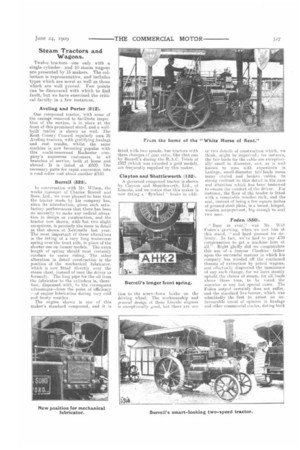
Page 16
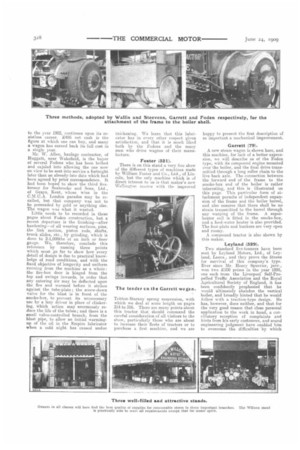
Page 18
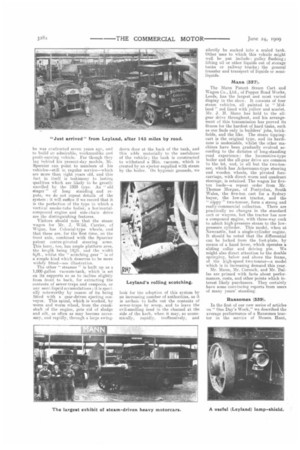
Page 19
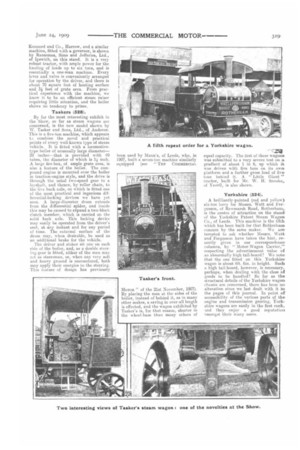
Page 20

Page 21
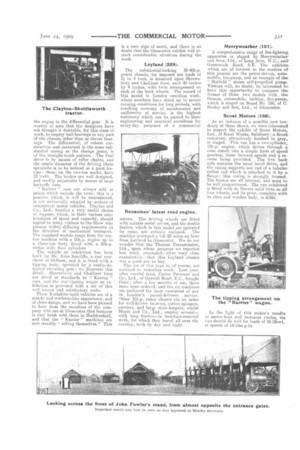
Page 22
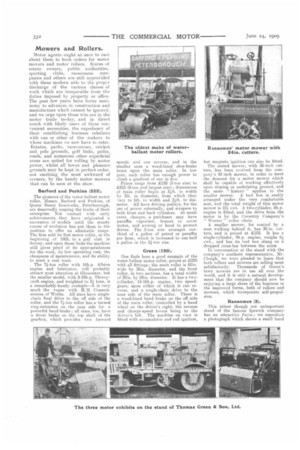
Page 23
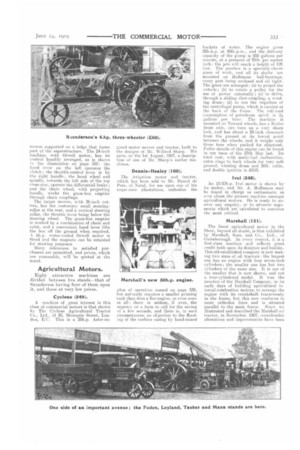
Page 24
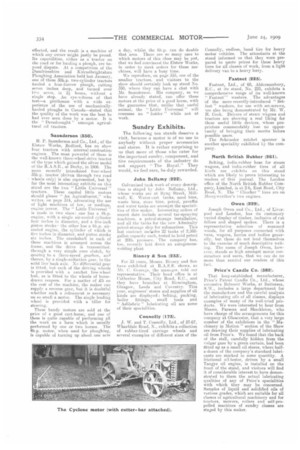
Page 25
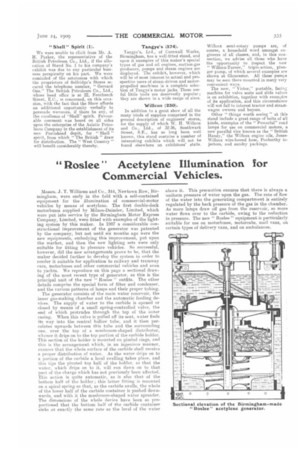
If you've noticed an error in this article please click here to report it so we can fix it.
Twelve tractors—one only with a. single cylinder—and 10 steam wagons are presented by 15 makers. The collection is representative, and includes types which are novel as well as those which are well proved. Few points can be discovered with which to find fault, but we have exercised the critical faculty in a few instances.
Aveling and Porter (212).
One compound tractor, with some of the casings removed to facilitate inspection of the motion, is in place at the front of this prominent stand, and a wellbuilt trailer is shown as well. The Kent County Council regularly uses 16 Aveling tractors, with gratifying haulage and cost results, whilst the same machine is now becoming popular with this world-renowned Rochester company's numerous customers, in all branches of service, both at home and abroad. It is listed at £500. The necessary parts for rapid conversion into a road roller cost about another £150.
Burrell (525).
In conversation with Mr. 'Wilson, the works manager of Charles Burrell and Sons, Ltd., we were pleased to hear that the tractor made by his company has,
since its introduction, given such satisfactory performances that there has been no necessity to make any radical alteration in design or construction, and the tractor now shown, with but two slight exceptions, is precisely the same in detail as that shown at Newcastle last year. The most important of these alterations is the fitting of a very long transverse spring over the front axle, in place of the shorter one on former models. The extra length of spring should most certainly conduce to easier riding. The other alteration in detail construction is the position of the mechanical lubricator, which is now fitted directly over the steam chest, instead of near the driver as formerly. The long pipe for the oil from the lubricator to the cylinders is, therefore, dispensed with, to the consequent advantages—from the point of efficiency —of engine lubrication during very cold and frosty weather. The engine shown is one of this maker's standard compound, and it is
fitted with two speeds, but tractors with three changes cf 4ear ratio, like that run by Burrell's during the R.A.C. Trials of 1907 (which was awarded a gold medal), are frequently supplied by this maker.
Clayton and Shuttleworth (132).
A governed compound tractor is shown by Clayton and Shmtleworth, Ltd.„ of Lincoln, and we notice that this maker is now fitting a ' flywheel " brake in addi tion to the screw-down brake on the driving wheel. The workmanship and gracraf design el these Lincoln engines is exceptionally good, but there are one
Or two details of construction which, we think, might he improved ; for instance, the fair-leads for the cable are exceptionally small in diameter, and, as is well known to men with experience in haulage, small-diameter fair leads mean many chafed and broken cables. in strong contrast to this detail is the care and attention which has been bestowed to ensure the comfort of the driver. For instance, the floor of the tender is fitted with a removable wooden rack, and the seat, instead of being a few square. inches of pressed-steel plate, is a broad, hinged., wooden arrangement, big enough to seat two men.
roden (MO).
" Busy as ever," was Mr. Will }den's greeting, when we net him at this stand, " and hard pressed for delivery. In fact, we've had to pay 1110 compensation to get a machine here at all." Right gladly did we congratulate this son of a famous Cheshire father upon the successful manner in which his company has warded off the continued threats of extinction by petrol wagons, and effectually disproved the imminence of any such change, for we have stoutly upheld the claims of steam, for all loads above three tons, to be voted the superior in any but special cases. The Foden output certainly does not suffer, and the standard five-tonner, which was admittedly the first to arrest an unfavourable trend of opinion in haulage and other commercial circles, dating back
to the year 1902, continues upon its resistless career. 2495 net cash is the figure at which one can buy, and many a wagon has earned back its full cost in a single year.
Mr. W. Allen, haulage contractor, of Huggatt, near Wakefield, is the buyer of several Fodens who has been bribed and cajoled into allowing the one now on view to be sent into service a fortnight later than an already-late date which had been agreed by prior correspondence. It had been hoped to show the third fivetonner for Seabrooke and Sons, Ltd., of Grays, Kent, whose wins in the C.M.U.A. London parades may be recalled, but that company was not to be persuaded by gold or anything else. The wagon was what it wanted.
Little needs to be recorded in these pages about Foden construction, but a recent departure is the finishing—after hardening—of all wearing surfaces, pins, the link motion, piston rods, shafts, trunk slides, etc., by grinding, which is done to 2-1,000ths of an inch or finer gauge. We, therefore, conclude this reference by naming three points which must go far to show how every detail of design is due to practical knowledge of road conditions, and with the fixed objective of longevity and uniform running from the machine as a whole : the fire-box door is hinged from the top and swings inwards, in order that any entering air may be deflected upon the fire and warmed before it strikes against the tube-plate ; the screw-down valve for the blast is in front of the smoke-box, to prevent its unnecessary use by a lazy driver in place of clinkering, which action may enormously reduce the life of the tubes; and there is a small valve-controlled branch, from the blast pipe, to allow an initial warmingup of the oil in the Empire lubricator when a cold night has caused undue thickening. We learn that this lubricator has in every other respect given satisfaction, and that it is much liked both by the fodens and the many men who drive wagons of their manufacture.
Foster (321).
There is on this stand a very fine show of the different types of machines made by William Foster and Co., Ltd., of Lincoln, but the only machine which is of direct interest to us is that maker's new Wellingtrm tractor with the improved Tritton-Starkey spring suspension, with which we deal at some length on pages 314 to 316. There are many points about this tractor that should command the careful consideration of all visitors to the show, particularly those who are about to increase their fleets of tractors or to purchase a first machine, and we are happy to present the first description of so important a mechanical improvement.
Garrett (79).
A new steam wagon is shown here, and this machine, for lack of a better expression, we will describe as of the Foden type, with its compound engine mounted over the boiler, and the final drive transmitted through a long roller chain to the live back axle. The connection between the forward end of the frame to the smoke-box end of the boiler is rather interesting, and this is illustrated on this page. This particular form of attachment permits of independent expansion of the frame and the boiler barrel, and also ensures that there shall be no strain transmitted to the barrel through any warping of the frame. A superheater coil is fitted in the smoke-box, and a feed-water heater is also provided. The foot-plate and bunkers are very open and roomy.
A compound tractor is also shown by this maker.
Leyland (529).
Two standard five-tonners have been sent by Leyland Motors, Ltd., of Leyland, Lanes., and they prove the fitness for survival of tins company's type. Ever since Mr. Henry Spurrier, junr., won two 2100 prizes in the year 1893, one each from the Liverpool Self-Propelled Traffic Association and the Royal Agricultural Society of England, it has been confidently prophesied that he would ultimately abandon the vertical boiler, and broadly hinted that he would follow with a traction-type design. He has, however, done neither, and that for the very good reason that close personal application to the work in hand, a conciliatory reception of complaints and hints from his early customers, and sound engineering judgment have enabled him to overcome the difficulties by which
he was confronted seven years ago, and to build an admirable, workmanlike and profit-earning vehicle. Far though they lag behind his present-day models, Mr. Spurrier can point to numbers of his vehicles—still in regular service—which are more than eight years old, and this fact in itself is testimony to lasting qualities which are likely to be greatly excelled by the 1.909 type. An" old stager " of long standing and repute, we do not repeat. details of the system it will suffice if we record that it is the perfection of the type in which a Vertical smoke-tube boiler, a horizontalcompound engine and side-chain drive are the distinguishing features.
Visitors should note that the steam wagon for Mr. J. Wild, Carrier, of Wigan, has Colonial-type wheels, and that these are, for the first time, on the front axle, combined with the Spurrier patent centre-pivoted steering arms. This lorry, too, has ample platform area, the length being 141ft. and the width 61-ft., whilst the " scotching gear " is of a simple kind which deserves to he more widely fitted—see illustration.
The other " steamer " is built up as a 1,000-gallon vacuum-tank, which is set on its supports so as to incline slightly from front to back, for extracting the contents of sewer-traps and cesspools, or any semi-liquid accumulations ; it is specially noteworthy by reason of its being fitted with a gear-driven ejecting conveyor. This spiral, which is worked, by worm and worm wheel, from the crankshaft of the engine, gets rid of sludge and silt, as often as may become necessary, ;Ind rapidly, through a large swing
down door at the back of the tank, and this adds materially to the usefulness of the vehicle; the tank is constructed to withstand a 26in. vacuum, which is created by an ejector supplied with steam by the boiler. On hygienic grounds, we look for the adoption of this system by an increasing number of authorities, as it is archaic to ladle out the contents of sewer-traps by scoop, and to leave the evil-smelling mud in the channel at the side of the kerb, when it may, so economically, rapidly, inoffensively, and
silently be sucked into a scaled tank. Other uses to which this vehicle might well be put include: gulley flushing; lifting oil or other liquids out of storage tanks or railway trucks; the general transfer and transport.of liquids or semiliquids.
Mann (327).
The Mann Patent Steam Cart and Wagon Co., Ltd., of Pepper Road Works, Leeds, has the largest and most varied display in the show. It consists of four steam vehicles, all painted in " Midland " red lined with yellow and scarlet. Mr. J. H. Mann has held to the allgear drive throughout, and his arrangement of this transmission has proved As Fitness for the hardest of hard tasks, such as one finds only in builders' jobs, brickfields, and the like. The steam tippingcart is the original type, and its hardiness is undeniable, whilst the other machines have been gradually evolved according to the dictates of long-standing road experience : the locomotive-type boiler and the all-gear drive are C0111111011 to the lot. and, in all but the two-tonnor, which. has Ackermann-type steering and wooden wheels, the pivoted forecarriage, with direct worm and quadrant steerage, is retained. The wagon for fiveton loads—a repeat order from Mr. Thomas Morgan, of Pontyclun, South Wales, the five-ton cart for a Sydney buyer, the low-set tractor, and the " nippy " two-tonner, form a strong and really-commercial collection. There are practically no changes in the standard cart or wagons, but the tractor has now a compound e9gine, with three-way cock to admit high-pressure steam to the lowpressure cylinder. This model, when at Newcastle, had a single-cylinder engine. It should be noted that the differential can be locked from the foot-plate, by means of a hand lever, which operates a sliding collar and driving pin. We might also direct attention to the double springing, below and above the frame, of the high-speed two-tonner—a model which is in increasing demand this year. Mr. Mann, Mr. Cornoch, and Mr. Dallas are primed with facts about performances, costs, and other points which in
likely purchasers. They certainly have some convincing reports from users of many years' standing.
Ransomes (559).
In the first of our new series of articles on " One Day's Work," we described the average performance of a Ransomas tractor in the service of Messrs. Hunt, Kennard and Co., Harrow, and a similar machine, fitted with a governor, is shown by Ransomes, Sims and Jefferies, Ltd., of Ipswich, on this stand. it is a very robust tractor, with ample power for the hauling of loads up to six tons, and is essentially a one-man machine. Every lever and valve is conveniently arranged fur operation by the driver, and there is about 70 square feet of heating surface and 3% feet of grate area. From practical experience with the machine, we know it to be an efficient steam raiser requiring little attention, and the boiler shows no tendency to prime.
Taskers (328).
By far the most interesting exhibit in the Show, so far as steam wagons are concerned, is the new model shown by W. Tasker and Sons, Ltd., of Andover. This is a five-ton machine, which appears t..) combine the novel and practical points of every well-known type of steam vehicle. It is fitted with a locomotivetype boiler of unusually large diameter28 inches—that is provided with 49 tubes, the diameter of which is 1i inch. A large fire-box, of ample grate area, is also a feature of the boiler. The compound engine is mounted over the boiler in traction-engine style, and the drive is through the usilal two-speed gear to a layshaft, and thence, by roller chain, to the live back axle, on which is fitted one of the most practical and ingenious differential-locking devices we have yet seen. A large-diameter drum extends from the differential spider, and inside this may be caused to expand a twodalock clutch member, which is carried on the solid back axle. This locking device may easily be operated from the driver's seat, at any instant and for any period of time. The external surface of the drum may, when desirable, be used as an additional brake for the vehicle.
The driver and stoker sit one on each side of the boiler, and, as a double steering-gear is fitted, either of the MOO may act as steersman, or, when any very soft and heavy ground is encountered, both may apply their energies to the steering. This feature of design has previously
been used by Mann's, of Leeds, who, in 1907, built a seven-ton machine similarly equipped (see "Tine COMMERCIAL MOTOR' of the 21st November, 1907). By placing the men at. the sides of the boiler, instead of behind it, as in many other makes, a saving in over-all length is effected, and the wagon exhibited by Tasker's is, for that reason, shorter in the wheel-base than many others of
equal capacity. The first of these wagons was submitted to a very severe test on a gradient of about 1 in 6, up which it. was driven with five tons on its own platform and a further gross load of five tons behind it. A " Little Giant " tractor, built for Mr. W. H. Snooks, of Yeovil, is also shown.
Yorkshire (524).
A brilliantly-painted (red and yellow) six-ton lorry or Messrs. Watt and Fergusson, of Rawrnarsh Road, Rotherham,. is the centre of attraction on the stand of the Yorkshire Patent Steam Wagon Co., of Leeds. This machine is the fifth which has been built for that Rotherham concern by the same maker. We are tempted to ask whether Messrs. Watt and Fergusson have taken the hint, recently given in our correspondence columns, by " Motor-Wagon Carrier," respecting the advertisement value of an abnormally high tail-board? We note that the one fitted on this Yorkshire wagon is about 4ft. fin, in height. Such a high tail-board, however, is necessary, perhaps, when dealing with the class of goods to be handled? So far as the structural details of the Yorkshire wagon chassis are concerned, there has been no alteration since we last dealt with it in the pages of this journal. In point of accessibility of the various parts of the engine and transmission gearing, Yorkshire wagons are easily in the first rank,
d they enjoy a good reputation amongst their many users. Other Exhibits of Tractors and a Wagon.
Amongst other exhibitors of steam tractors are: John Fowler and Co. (Leeds), Ltd_ (213); Robey and Co., Ltd. (353); Savage Brothers, Ltd. (135); and Wallis and Steevens, Ltd. (351). The last-named company also shows one of its five-ton steam wagons, which has been built to the order of Mr. S. C. Gilson, of Holcombe, Bath.
Fowler's tractor has a two-cylinder compound engine, with its valves arranged on the top of the cylinders instead of at the sides, as is the case with all other tractors at Gloucester. The transmission gear, like that. on the " Little Mann " tractor, is one of the " four-shaft '' type.
Savage Brothers' tractor is the only single-cylinder governed tractor in the Show, and another of its distinctive features is that it has wooden-shod driving As heels.
Petrol Vehicles.
We found, under this head, one wagon, one chassis, one van, and two " special " vehicles—the Dennis turbine fire-engine, the Merry w ea ther petrol-driven three-throw reciprocating-pump (radially arranged) fireengine.
Dennis-Healey (160).
A broadside view of two Dennis j: reductions is presented on the western front of the attractive stand for which C. Healey and Son, Ltd., of Gloucester, is responsible. These are: the Dennis motor fire-engine with Owynne-Sargeant two-stage turbine pump ; and the Dennis agricultural and irrigation motor with similar equipment. Each combination is of a unique character, and the compactness of the outfit lends added interest to the designs. A four-cylinder Dennis engine is employed for each machine, with standard Dennis chassis and worm-driven back axle, but modifications of the intermediate transmission have been introduced, in order to suit the altered conditions of working which the several applications of the power have shown to be imposed.
Thus, in the 35h.p. fii-e engine, the features of interest are: the ability of the engine to start out from the station without any delay in getting ready; its high road-speed (30m.p.hr.) and ample reserve of power for hill-climbing ; its ability, on arriving at the scene of the conflagration, to direct a high-pressure first-aid jet 'instanter at the seat of the
fire; its capacity to work for many hours on end without supplies other than a maximum of 3i gallons of petroleum spirit per hour ; a delivery capacity of from 350 to 400 gallons of water per
minute; indifference to muddy or gritty water; ability to " lift " water from a pond or river the full depth which is physically possible by vacuum—say, 30 feet; and the facile and automatic reception of supply from town's mains and augmentation of delivery pressure to nozzles. For fuller details, we must refer enquirers to our issues of the 23rd July and the 24th September, 1908. Kingston-on-Thames is the latest brigade to order two of these engines.
"Karrier" Cars (325).
Clayton and Co. (Huddersfield), Ltd., of Union Works, Huddersfield, has the only display which is confined solely to petrol-driven " cars for commerce." The single exhibit, a two-ton wagon, is typical of the various classes of weight-carrying machines turned out by this maker ; this complete vehicle reached the Show grounds on Friday last, borne by a sister chassis, in order that the lung road journey from Huddersfield should not leave any trace upon the new paint and the new tires. Such a journey is in itself excellent testimony to the load capacity and the adaptability of the " Karrier design, having regard to the time. The two-ton wagon which is exhibited, and anather example of the same type which is in attendance outside the grounds for trial-run purposes, is of the maker's standard, two-cylinder, chain. driven pattern. The cylinders of the Tylor engine have a bore of five inches, and the piston stroke is 5i inches ; 20 brake horse-power is developed at 850 revolutions. The engine which is fitted to the vehicle on the stand is provided with low-tension-magneto ignition, but we were informed by Mr. G. F. Clayton that the company's standard practice provides for the high-tension Bosch magneto system. The clutch is of the multiple-disc Hele-Shaw type. The substantially-built gearbox has three forward speeds and a reverse gear, all of which are operated by a single lever in a gate type of quadrant. The forward gears are designed to give to the vehicle speeds of 3, 6i and 12 miles per hour, and the top speed is a direct drive from the engine to the differential gear. It is worthy of note that the designers have not thought it desirable, for this class of work, to employ ball-bearings in any part of the chassis, other than as thrust bear The differential, of robust construction and contained in the same substantial casing as the change gears, is of the straight-tooth pattern. The final drive is by means of roller chains, and the ample diameter of the driving chain sprockets is to be noticed as a good feature; these, on the two-ton model, have 12 teeth. The brakes are well designed, and readily adjustable by means of large butterfly nuts.
" Karrier " cars are always sold at prices which include the tires ; this is a practice which, it will he remembered, is not universally adopted by makers of commercial motor vehicles. Clayton and Cu., Ltd., handles a very useful choice of wagons, which, in their various combinations of speed and capacity, should appeal to many visitors to the Show who possess widely-differing requirements in the direction of mechanical transport. The standard models range from the oneton machine with a 16h.p. engine up to a three-ton lorry fitted with a 30h.p. motor with four cylinders
The vehicle on exhibition has been built for Mr. John Sutcliffe, a coal merchant of Oldham, and it is fitted with a tipping body, operated by a neatly-designed elevating gear ; we illustrate this detail. Shrewsbury and Challiner tires are fitted as standards to " Karrier " cars, and the coal-tipping wagon on exhibition is provided with a set of this well-kw:11m and satisfactory make.
These Yorkshire-built vehicles are of a sturdy and workmanlike appearance, and of dean design, and we have been pleased to hear from the members of the company who are at Gloucester that business is very brisk with them in Huddersfield, and AM the " Karrier " machines are now steadily " selling themselves." This is a sure sign of merit., and there is no doubt that the Gloucester exhibit will attract considerable attention during the week.
Leyland (329).
The substantial-looking 30-40h.p. petrol chassis, for imposed net loads of 31 to 4 tons, is mounted upon Shrewsbury and Challiner tires, each 40 inches by 4 inches, with twin arrangement on each of the back wheels. The record of this model in London omnibus work, where numbers have stood up to severe running conditions for long periods, with resulting economy of maintenance and uniformity of service, is the highest testimony which can be quoted to their engineering and practical Roundness for every-day purposes of a commercial
nature. The driving wheels are fitted with outside metal covers, and the double brakes, which in this model are operated by cams, are entirely enclosed. The machine averaged a lull 20 miles an hour from Leyland to Gloucester. We do not wonder that the Thomas Transmission, Ltd., upon whose progress we reported last week, concluded—after very close examination—that this Leyland chassis was a good one to buy.
The use of this type is, of course, not confined to motorbus work. Last year, after careful trial, Carter Paterson and Co., Ltd., of Goswell Road, E.G., bought three ; after a few months of use, three more were ordered, and the six machines are reckoned the most consistent of any in London's parcel-delivery service. Other 35h.p. sister chassis are on order for well-known brew sra, cotton-spinners, carriers, and large store-keepers, whilst Maple and Co., Ltd., employ several— with long frames—in furniture-removal work, for which they travel all over the country, both by day and night. A comprehensive range of fire-fighting apparatus is staged by Merryweather and Sons, Ltd., of Long Acre, W.C., and Greenwich Road, S.E. The exhibitswhich are of interest to the readers off this journal are the petrol-driven, automobile, fire-pump, and an example of the " Hatfield " steam self-propelled pump. Visitors will, no doubt, be interested to have this opportunity to compare the former of these two models with the Dennis, automobile, turbine, fire-pump, which is staged on Stand No. 160, of GHealey and son, Ltd., of Gloucester.
Scout Motors (168).
As an instance of a possible new tendency at these shows, we were interested to inspect the exhibit of Scout Motors, Ltd., of Scout Works, Salisbury : a Scout. motorvan, attractively finishea in grey, is staged. This van has a two-cylinder, 12h.p. engine, which drives through a cone clutch into a simple form of speed gearbox, three forward speeds and a reverse being provided. The live back axle contains the usual bevel drive, and the casing supports one end of a tubularradius rod which is attached to it by a. flange; this casing is strongly trussed. The brakes are all internal, and seem to be well proportioned. The van exhibited is fitted with de Nevers solid tires on allt four wheels, and its price, complete with its tires and wooden body, is £360. 3lotor agents ought at once to cast about them to book orders for motor mowers and motor rollers. Scores of estate owners, public authorities, sporting clubs, racecourse companies and others are still unprovided with these modern aids to the proper discharge of the various classes of work which are inseparable from the duties imposed by property or office. The past few years have borne testimony to advances in construction and manufacture which cannot be ignored, and we urge upon those who are in the motor trade to-clay, and in direct touch with likely users of these convenient necessities, the expediency of their establishing business relations with one or other of the makers to whose machines we now have to refer. Estates, parks, racecourses, cricket and polo grounds, golf links, paths, roads, and numerous other superficial areas are suited for rolling by motor power, whilst all lawns and pleasure grounds may be kept in perfect order, not omitting the most awkward of corners, by the handy motor mowers that can be seen at the show.
Barford and Perkins (552).
The pioneers of the water-ballast motor roller, Messrs. Barford and Perkins, of Queen Street Ironworks, Peterborough, are deservedly reaping the fruits of their enterprise. Not content with early achievements, they have originated a succession of models until the steady course of evolution has put them in the position to offer an admirable range. The firm sold its first motor roller, at the beginning of 1905, to a golf club in Surrey, and upon those links the machine still gives proof of its appropriateness for the work, its low operating cost, the cheapness of maintenance, and its ability to meet a real want.
The 7k-ton roller with 16h.p. Albion engine and lubricator, will probably attract most attention at Gloucester, but the smaller model, with 8-10h.p. Timmycroft engine, and weighted to 3 tons, is a remarkably-handy exaMple—it is very much the vogue with 11.31. Commissioners of Works. All sizes have singlechain final drive to the off side of the roller, and the Th.ton roller has a turned ring-extension on the near side for a powerful band.brake ; all sizes, too, have a drum brake on the top shaft of the gearbox, which provides two forward
speeds and one reverse, and in the smaller ones a wood-lined shoe-brake bears upon the main roller. In low gear, each roller has enough power to climb a gradient of one in five.
Prices range from £195 (3-ton size) to £410 (9-ton and largest size); dimensions of main roller begin at 3ft. in width by 3ft. in diameter, from which they rary to 6ft. in width and 31ft, in diameter. All have driving pulleys, for the use of power externally, and scrapers to both front and back cylinders. At small extra charges, a purchaser may have paraffin vaporiser, bonnet to cover motor, and awning or hood to protect driver. The 3-ton size averages onethird of a gallon of petrol or paraffin per hour, which is increased to one-half a gallon in the 5i-ton size.
Green (120).
One finds here a good example of the water-ballast motor roller, priced at £225 with all fittings; the main roller is 42in. wide by 36in. diameter, and the front roller, in two sections, has a total width of 30m. by 24iii. diameter. It has a twocylinder, 14-16h.p. engine, two speedgears, upon either of which it can reverse, and a single-chain drive to the near side of the main roller. There is a wood-lined band brake on the off side of the main roller, controlled by a hand wheel on the driver's right, the reverse and change-speed levers being to the driver's left, The machine on view is fitted with accumulator and coil ignition,
but magneto ignition can also be fitted.
The seated mower, with 36-inch cutters, has been evolved from the company's 42-inch mower, in order to meet the demand for a motor mower which shall be capable of working effectively upon sloping or undulating ground, and the same " history " applies to the smaller mower, A tool box is neatly arranged under the very comfortable seat, and the total weight of this motor mower is 10 cwt. A two-cylinder, 8h.p. engine is fitted, and the drive from the motor is by the Coventry Company's " Worm° " miler chain.
A smaller mower, for control by a man walking behind it, has 30-in, cutters, and is priced at £105. It has a single-cylinder, 4h.p. engine, weighs 6i cwt., and has its tool box slung on a dropped cross-bar between the arms, In conversation at the stand with the company's southern representative, Mr. Clongh, we were pleased to learn that both rollers and mowers are selling most satisfactorily. Thousands of Green's lawn mowers are in use all over the world, and it is only a natural develop. ment that the company should now be enjoying a large share of the business in the improved forms, both of rollers and mowers, which incorporate self-propulsion.
Itansomes (5).
This miner though not unimportant stand of the famous Ipswich company has an attractive facie; we reproduce a photograph which shows a small hand
mower supported on a ledge that forms part of the superstructure. The 24-inch machine, with Orwell motor, has its control handily arranged, as is shown in the illustration on page 332: the hand lever on the left operates the clutch ; the throttle-control lever is by the right handle ; the hand wheel and spindle, towards the left side of the top cross-stay, operate the differential brake; and the chain wheel, with projecting handle, works the grass-box emptier through chain couplings. The larger mower, with 36-inch cutters, has the customary small steeringroller at the rear, and a vertical steering pillar, the throttle lever being below the steering wheel. The grass-box emptier is worked by a combination of chain and cable, and a convenient hand lever lifts the box off the ground when required. A 6h.p. water-cooled Orwell motor is fitted and the magneto can be retarded for starting purposes.
Many references to satisfied purchasers are permitted, and prices, which are reasonable, will be quoted at the stand.
Agricultural Motors.
Eight attractive machines are divided between five stands—that of Saunderson having four of them upon it, and these at very low prices.
Cyclone (549).
A :tiaehine of great interest in this class of commercial motors is that shown by The Cyclone Agricultural Tractor Cu., Ltd., of 30, Moorgate Street, London, E.C. This is a 20h.p. Aster-en
gined motor mower and tractor, built to the designs of Mr. Wilfred Sharp. We gave, on the 1st August, 1907, a description of one of Mr. Sharp's earlier machines.
Dennis-Healey (160).
The irrigation motor and tractor, which has been sold to Mr. Daniel de Pass, of Natal, for use upon one of his sugar-cane plantations, embodies the plan of operation named on page 330, but natgratly requires a smaller priming tank than does a fire-engine, or even none at all: there is seldom, if ever, the urgency on a farm to call for the saving of a few seconds, and there is, in such circumstances, no objection to the flooding of the turbine casing by hand-raised buckets of water. The engine gives 28b,h.p. at 900r.p.m., and the delivery capacity of the pump is '250 gallons per minute, at a pressure of 701b. per square inch: the jets will reach a height of 120 feet. The gearbox is a specially-clever piece of work, and all its shafts are mounted on Hoffmann ball-bearings, every part being enclosed and oil tight. The gears are arranged : (a) to propel the vehicle; (b) to rotate a pulley for the use of power externally; (c) to drive, through a sliding claw-coupling, a winding drum ; (d) to run the impellors of the centrifugal pump, which is carried at the back of the frame. The full-load consumption of petroleum spirit is 3A gallons per hour. The machine is mounted on Toward wheels, has a Butler front axle, can turn on a very sharp lock, and has about a 20-inch clearance from the ground at its lowest point between the wheels, and it weighs only three tons when packed for shipment. Fuller details of this engine can be found in our issue of the 27th May last. Its total cost, with multi-fuel carburetter, extra rings to back wheels for very soft ground, winding drum and 50ft. cable, and double ignition is £615.
Ivel (348).
An 18-20h.p. Ivel motor is shown by its maker, and Mr. A. Hoffmann may be found in charge as enthusiastic as ever about the pioneer machine amongst agricultural motors. He is ready to answer any enquiry, or to advance arguments which are calculated to convince the most critical.
Marshall (131).
The finest agricultural motor in the Show, beyond all doubt, is that exhibited by Marshall, Sons, and Co., Ltd., of Gainshorough. In every respect, it is a first-class machine and reflects great credit both upon its designer and buildei. this old-established company is now making two sizes of oil tractors: the largest one has an engine with four seven-inch cylinders; the smaller one has but two cylinders of the same size. It is one of the smaller that is now shown, and not a four-cylindered model. It was the practice of the Marshall Company, in its early days of building agricultural internal-combustion motors, to arrange the engine with its crankshaft transversely in the frame, but this now conforms to more orthodox lines and is situated parallel to the main frame. Since we illustrated and described the Marshall oil tractor, in November, 1907, considerable alterations and improvements have been
effected, and the result is a machine of which any owner might justly be proud. Its capabilities, either as a tractor on the road or for hauling a plough, are beyond dispute. At a competition of the Dumfriesshire and Kircudbrightshire Ploughing Association held last January, one of these 30h.p. two-cylinder tractors hauled a four-furrow plough, cutting seven inches deep, and turned over two acres, in 2 hours, without a single stop. An eye-witness of that test—a gentleman with a wide experience of the use of mechanicallyhauled ploughs in Canada—stated that the quality of the work was the best he had ever seen done by a motor. It is the " Dreadnought " amongst agricultural oil tractors.
Saunderson (350).
P. Saunderson and Co., Ltd., of the Elstow Works, Bedford, has on show four tractors with internal-combustion engines. The most powerful of these is the well-known three-wheel-drive tractor of the type which gained the silver medal of the R.A.S.E., at Derby, in 1906. The more recently introduced four-wheel 35h.p. tractor (driven through two road wheels only) is also represented, but by far the most interesting exhibits on this stand are the two " Little Universal tractors. These capital little motors should please " An Agriculturist," who writes, on page 314, advocating the use of light machines of low, or medium, engine power. The " Little Universal " is made in two sizes: one has a 4h.p. engine, with a single air-cooled cylinder four inches in diameter, and a five-inch piston stroke the other has a 6h.p. aircooled engine, the cylinder of which is five inches in diameter, and piston stroke six inches. The crankshaft in each of these machine is arranged across the frame, and the drive is transmitted. through a very simple cone clutch, by gearing to a three-speed gearbox, and thence, by a single-reduction gear, to the solid live back axle. No differential gear is fitted, but each of the driving wheels ig provided with a ratchet free-wheel hub, as is fitted to the wheels of horse
drawn reapers. For a matter of on the cost, of the machine, the maker can supply a reverse gear, but it is doubtful whether such a refinement is necessary on so small a motor. The single leading wheel is provided with a tiller for steering.
These handy motors are sold at the price of a good cart-horse, and one of them is quite capable of performing all the work on a farm which is usually performed by one or two horses. The
4h.p. motor, when used for ploughing, is capable of turning up about one acre
a day, whilst the 6h.p. can do double that area. There are so many uses to which motors of this class may be put, that we feel convinced the Elstow Works, in order to meet orders for these machines, will have a busy time. We reproduce, on page 333, one of the smaller tractors, and visitors to the show should certainly look up stand No. 350, where they can have a chat with Mr. Saunderson. his company, as we have already stated, can offer these motors at the price of a good horse, with the guarantee that, unlike that useful animal, the " Little Universal " will consume no 'fodder " while not at work.
Sundry Exhibits.
The following ten stands deserve a visit, because a motor is of no use to anybody without proper accessories and stores. It is rather surprising to us that more of those who cater for the important sundry, component, and tire requirements of the industry do not support " The Royal." They would, we feel sure, be duly rewarded.
John Bellamy (222).
Galvanised tank work of every description is staged by John Bellamy, Ltd., whose works arc at Byng Street, Millwall, E. Water-cart tanks, sand bins, waste bins, store bins, petrol, paraffin and water tanks are amongst the specialities of this maker. Interesting order's of recent date include several tar-spraying machines, a petrol-storage installation, and all the tanks for the new Admiralty petrol-stun-ago ship for submarines. This last contract Ind/Kies 22 tanks of 2,500gallon capacity each, tested to hold petrol at 201b. pressure. The company has, too, recently laid down an autogenouswelding plant
Binney & Son (233).
For 33 years, Messrs. Blaney and Son have exhibited at R.A,S.E. shows, so Mr. C. Gessage, the manager, told our representative. Their head office is at Catherine Rouse, City Road, E.G., and they have branches at Birmingham, Glasgow, Leeds and Coventry. This year, engineers' stores and supplies of all kinds are displayed ; belting, packing, boiler fittings, small tools and " Asblnbric " lubricating oil are some of thouspecialities.
Connolly (175).
J. W. and T. Connolly, Ltd., of 57-67, Wharfdale Road, N., exhibits a collection of rubber-tired carriage wheels and several examples of different sizes of the
Connolly, endless, band tire for heavy motor vehicles. The attendants at the stand informed us that they were prepared to quote prices for these heavy tires for all classes of work, from a light delivery van to a heavy lorry.
Fastnut (225).
lastnut, Ltd., of 60, Aldermanbury, E.C., at its stand, No. 225, exhibits a comprehensive range of its well-known " Fastnut,'" washers. The advantages of the more-recently-introduced " Setfast " washers, for use with set-screws, are also being demonstrated by Mr. W. H. Cook. Drivers of steam wagons and tractors are showing a real liking for these useful little devices, whose pro. prictors commendably lose no opportunity of bringing their merits before possible users.
'The Schroeder ratchet spanner is another speciality exhibited by the company.
North British Rubber (261).
Belting, india-rubber hose for steam wagons, and Melia-rubber tires of all kinds are exhibita this stand which are likely to prove interesting to readers of this journal. The London office of the North British Rubber Company, Limited, is at 2-6, East Road, City Road, N. The ' Clincher " tires are on Merry weather's two engines.
Owen (229), Joseph Owen and Co., Ltd., of Liverpool and London, has its customary varied display of timber, inclusive of cut felloes and shaped spokes. There is a representative selection of seasoned woods, for all purposes connected with vans, wagons, lorries and bodies generally, but these do not lend themselves to the exercise of much descriptive writing. The name of Joseph Owen, however., stands so high amongst motor constructors and users, that we can do no more than remind our readers of this fact, Price's Candle Co. (382).
That long-established manufacturer, Price's Patera Candle Co., Ltd., whose extensive Belmont Work, at Battersea, S. W., includes a large department for the manufacture anti the careful analysis of lubricating oils of all classes, displays examples of many of its well-tried products. We were interested to hear from Messrs. Parsons arid Shackleton, who have charge of the arrangements for this company at Gloucester, that a very large number of the exhibitors in the " Machinery in Motion " section of the Show are drawing their supplies of lubricating oil from Price's. We found that the back of the stall, carefully hidden from the vulgar gaze by.a green curtain, had been fitted up as a small oil stores, where halfa-dozen of the company's standard lubricants are stcicked in some quantity. A frictional oil-tester, driven by a small Tangye oil engine, is installed on the front of the stand, and visitors will find it of considerable interest to have demonstrated to them the actual lubricating qualities of any of Price's specialities with which they may be concerned. Samples of liquid and solidified oils of various grades, which are suitable for all classes of agricultural machinery and for tractors, mowers, rollers and self-propelled machines of sundry classes are staged by this maker. "Shell" Spirit (1).
We were unable to elicit from Mr. A. H. Parker, the representative of the British Petroleum Co., Ltd., if the allocation of Stand No. 1 to his company's exhibit was due to any particular business perspicuity on his part. We were reminded of the astuteness with which the proprietors of Selfridge's Stores aecured the telephone number, " Gerrard One." The British Petroleum Co., Ltd., whose head office is at 22, Fenchurch Street, EC, is concerned, on this occasion, with the fact. that the Show affords an additional opportunity verbally to persuade waverers. if there be any, of the excellence of "Shell" spirit. Favourable comment was heard on all sides upon the enterprise of the Asiatic Petroleum Company in the establishment of its new Portishead depot, for " Shell " spirit, from which "The British" draw for distribution. The " West Country " will benefit considerably thereby. Tangye's (374).
Tangye's, Ltd., of Cornwall Works, Birmingham, has a well-fitted stand, and upon it examples of this maker's special types of gas and oil engines, suction-gas producers, pumps and steam engines are displayed. The exhibit, however, which will be of most interest to actual and prospective users of steam-driven and motorpropelled machines is a complete selection of Tangye's motor jacks. These useful little tools are deservedly popular ; they are shown in a wide range of sizes.
Willcox (230).
In addition to a great show of all the many kinds of supplies comprised in the general description of engineers' stores, for the supply of which W. H. Willcox and Co., Ltd., of 32-36, Southwark Street, S.F.., has so long been well known, this stand contains a number of interesting exhibits which will not be found elsewhere on exhibitors' stalls. Willcox semi-rotary pumps are, of course, a household word amongst engineers of all classes, and, in this connection, we advise all those who have the opportunity to inspect the new " Willcox-Turner," triple-action, plunger pump, of which several examples are shown at Gloucester. All these pumps may be seen there mounted in many very convenient ways. The new, " Victor," portable, facing machine for valve seats and slide valves is on exhibition, together with examples of its application, and this circumstance will not fail to interest tractor and steamwagon owners and buyers.
Other " things worth seeing " at this stand include a great range of belts of all kinds, examples of the "Powerful" road lamps for use on commercial motors, a new parallel vice known as the " British Handy," the Willcox engine oils, JonesWilcox wire-bound hose, Penberthy injectors, and sundry packings.
































